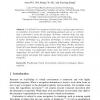Free Online Productivity Tools
i2Speak
i2Symbol
i2OCR
iTex2Img
iWeb2Print
iWeb2Shot
i2Type
iPdf2Split
iPdf2Merge
i2Bopomofo
i2Arabic
i2Style
i2Image
i2PDF
iLatex2Rtf
Sci2ools
HCI
2007
2007
Evaluation of Wayfinding Aids Interface in Virtual Environment
It is difficult for a navigator to find a way to a given target location in an unfamiliar environment. Often, wayfinding guidance such as an overview map is provided to assist the navigator. However, overview maps can only show survey knowledge at one particular scale, and cannot provide other kinds of spaital knowledge (e.g. procedure knowledge) or survey knowledge at different scales. In this study, we compared effectiveness, efficiency and satisfaction of three wayfinding aids, View-in-View Map (VVM), Animation Guide (AG) and Human-System Collaboration (HSC) in support of navigation in virtual reality. Our experiment results show that while an overview still outperforms AG and HSC, AG serves better for most people with ordinary spatial ability and people with superior spatial ability tends to perform better using HSC.
| Added | 29 Oct 2010 |
| Updated | 29 Oct 2010 |
| Type | Conference |
| Year | 2007 |
| Where | HCI |
| Authors | Anna Wu, Wei Zhang, Bo Hu, Xiaolong Zhang |
Comments (0)

